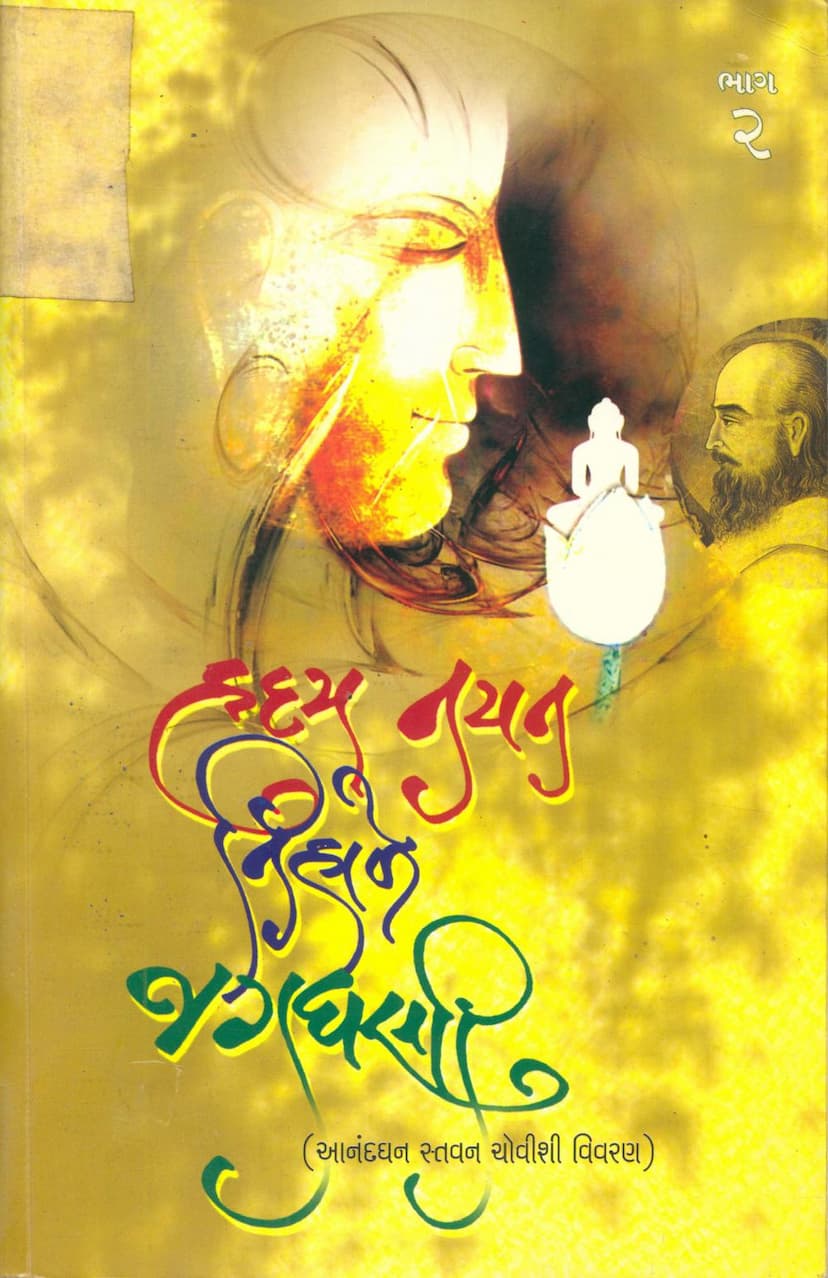Hriday Nayan Nihale Jagdhani Part 02
Added to library: September 1, 2025

Summary
I am unable to access external links, including the catalog link you provided (https://jainqq.org/explore/005856/1). Therefore, I cannot provide a summary of the Jain text based on that link.
However, based on the provided Gujarati text, I can offer a general overview of the themes and content that appear to be present in "Hriday Nayan Nihale Jagdhani Part 02":
General Overview of the Text's Content:
The provided text is a commentary ("Vivarana") on the "Anandghan Stavan Chovishi" (a collection of 24 devotional songs or stanzas by Anandghan). This second part of the commentary, titled "Hriday Nayan Nihale Jagdhani" (The Heart and Eyes Perceive the Lord of the Universe), focuses on interpreting the spiritual and philosophical essence of Anandghan's devotional verses.
The text seems to be structured around an analysis of each of the 24 stanzas dedicated to different Tirthankaras (Jain spiritual leaders). For each stanza, the text provides:
- Stavan Number and Verse Count: Indicating which Tirthankara's praise is being discussed.
- Dhrubh Panti (Refrain Line): The main theme or recurring line of the stanza.
- Pradhan Sur (Main Theme): A concise summary of the primary spiritual concept addressed in the stanza.
- Vivarana Patra: The page number where the detailed commentary can be found.
Key Themes and Concepts (as suggested by the table of contents and stanza titles):
The commentary appears to delve into various aspects of Jain philosophy and practice, as exemplified by the stanzas dedicated to different Tirthankaras. Some of the prominent themes likely covered include:
- Devotional Love and Purity: Stanzas focusing on Rishabh Jinesar might emphasize pure, unadulterated devotion.
- The Path to Liberation (Moksha): The commentary likely guides the reader on the spiritual path leading to spiritual liberation.
- The Nature of the Soul and the Divine: Discussions may explore the soul's intrinsic nature, its connection to the divine, and the different states of the soul (Antaratma, Paramatma).
- Knowledge and Devotion (Jnana Yoga and Bhakti Yoga): The text seems to analyze the interplay and integration of knowledge and devotional practices.
- Self-Realization and Inner Purity: Various stanzas might focus on shedding external attachments and realizing the inner divine presence.
- The Importance of True Spirituality: The commentary likely differentiates between superficial religious practices and genuine spiritual realization.
- The Role of Saints and Spiritual Teachers: Discussions may highlight the guidance of enlightened beings and the importance of following their teachings.
- The Significance of Jain Principles: The text probably elaborates on core Jain tenets like ahimsa, non-attachment, and self-control.
- Overcoming Inner Obstacles: Overcoming the mind's distractions, controlling desires, and conquering inner enemies like passions (kashayas) are likely explored.
- The Ultimate Goal of Liberation: The ultimate aim of attaining Moksha, shedding karma, and realizing the soul's pure, omniscient, and blissful nature is a central theme.
Specific Stanzas and their Commentary (Examples):
The provided text includes excerpts from the commentary on specific stanzas, such as:
- Stanza 11 (Shreyansnath): Discusses the concept of "Adhyatma" (spirituality or self-realization) and differentiates between true spirituality and mere outward show. It emphasizes the importance of knowing the inner self (Atman) to become a true knower.
- Stanza 12 (Vasu Pujya): Focuses on the multifaceted nature of consciousness (Chetna), differentiating between pure consciousness (pure knower/seer), impure consciousness (associated with karma), and the consciousness that experiences the fruits of karma.
- Stanza 13 (Vimalnath): Explores themes of overcoming desires, the fleeting nature of worldly possessions, and the steadfastness of the soul's true nature, contrasting the ephemeral with the eternal.
- Stanza 14 (Anantnath): Likely deals with the concept of infinity and the detachment required to achieve it, possibly contrasting external actions with their inner spiritual significance.
- Stanza 15 (Dharma-nath): Focuses on the essence of Dharma, the difficulty of understanding it, and the path to spiritual peace.
- Stanza 16 (Shanti-nath): Addresses the quest for peace (Shanti) and how to attain it, likely through meditation and inner stillness.
- Stanza 17 (Kunthu-nath): Discusses the restlessness of the mind and the challenge of controlling it, even amidst spiritual practices.
- Stanza 18 (Aranath): Explores the distinction between the self (Atman) and the non-self (body, senses), and the path to knowing the true self.
- Stanza 19 (Mallinath): Delves into the concepts of overcoming passions and desires, and the ultimate state of detachment.
- Stanza 20 (Munisuvrat): Discusses the nature of the mind and the path to its control, potentially through knowledge and detachment.
Overall Purpose:
The commentary aims to provide a profound and insightful explanation of Anandghan's devotional verses, guiding the reader towards a deeper understanding of Jain spiritual principles and the path to self-realization and liberation. It encourages introspection and the purification of the mind and soul.
If you can provide more specific information or text from the book, I might be able to offer a more targeted summary.